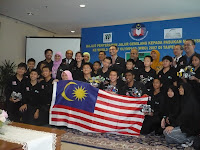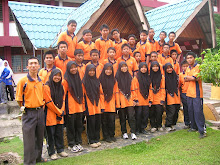

There are many experiment involved the use of trolley with ticker timer and ticker tape to determine physical quantities such as displacement, velocity and acceleration in Physics Form 4. Usually, teacher will conduct the experiment according to the method stipulated in the textbook.
However, the result of the experiment is not accurate. This experiment has been used for over 20 years in the Physics syllabus. The problems encountered in the experiment are as below:
a) Friction from the wheel of trolley and runway.
It is difficult to determine the height for a ‘friction compensated runway’.
b) Friction between ticker timer and ticker tape.
The speed of trolley is slow down tremendously.
c) Long runway
The runway is about 5 meter long and it is very heavy for the student to handle alone. The smoothness of the runway is questionable. The length of the runway causes a slight bend at the middle of the runway.
d) Set up time
It is time consuming to set up the experiment because there are too many apparatus to prepare and handle within a short time period.
Student and teacher are frustrated by the problems from this experiment.
OBJECTIVE
1. To improve the accuracy of the apparatus.
2. To introduce the idea of simple method but yet effective in enhancing the students’ understanding in the topic.
3. Incorporated ICT into the teaching of Physics in the classroom.
4. Fully utilized the LEGO Robotic Kit supplied by the Ministry of Education.
BENEFITS FOR TEACHING-LEARNING PROCESS
1. Experiment can be conducted successfully by the students. This will enhance the understanding of the students towards the concept taught by the teacher. It is a great frustration for the students if they cannot get the result as being expected due to the apparatus.
2. Experiment can be set up easily and effectively. This can save the teacher a lot of time in the class. Syllabus can be completed earlier.
3. Improve data analysis skill of the students.
4. Application of ICT in the classroom.
5. No more headache causes by the messy ticker tape and wire connection.
APPARATUS / MATERIALS
LEGO NXT 9797, Runway with masking tape, computer, LEGO Bricks.
CONSTRUCTION OF TEACHING AIDS
1. Teacher prepares a simple trolley with LEGO Robotic Education Kit. One light sensor is being attached to the front of the trolley.
2. Teacher prepares a runway with 10 masking tape arranged in parallel. The distance between the masking tape is 10cm.
3. Download a simple program to the NXT.
IMPLEMENTATION
1. Teacher refreshes the students on concept of velocity, average velocity and displacement.
2. Students make short notes about topic.
3. Students are divided into 6 groups.
4. Students adjust the height of runway to create fiction compensated runway.
5. Students turn on the NXT and push the trolley down the runway.
6. Students download the data into a computer.
7. Students transfer time of the motion into a table.
8. Students calculate the velocity and average velocity of the motion.
9. Students try 5 topical questions.
10. Teacher makes a conclusion based on activities conducted in the class.





 Robotics Adventure Centre
Robotics Adventure Centre















































